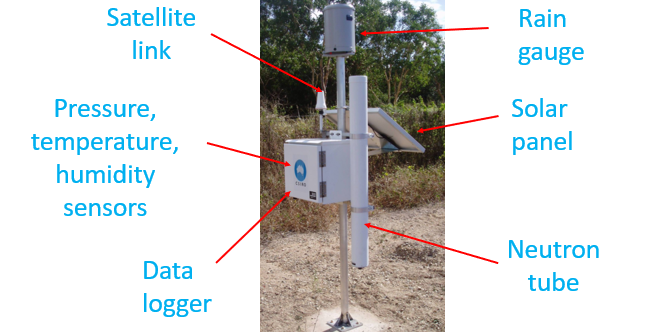“It is amazing to think that a star that exploded millions of years ago and millions of km away is telling us about soil moisture today”
From cosmic rays to critical climate data: TERN’s CosmOz network transforms space science into terrestrial insights
By Dr David McJannet, CSIRO
The Cosmic Connection
It might sound like science fiction, but exploding stars billions of kilometers away are helping Australian scientists measure soil moisture with unprecedented precision. TERN’s innovative CosmOz network harnesses cosmic rays—high-energy particles produced by supernovae—to monitor soil water content across the continent.
When these cosmic rays, travelling at nearly the speed of light, reach Earth’s atmosphere, they collide with atmospheric nuclei and create cascades of secondary particles. This cosmic “spallation” process generates neutrons that penetrate the soil surface, where they interact with hydrogen atoms—primarily found in soil water.
The Science Behind the Sensors
The principle is elegantly simple: the more water in the soil, the fewer fast neutrons are detected. This inverse relationship occurs because hydrogen is the most effective element at slowing down neutrons. Since soil water represents the largest and most dynamic source of near-surface hydrogen, cosmic-ray neutron sensors can accurately measure soil moisture changes over time.
“The cosmic-ray soil moisture sensor counts the number of fast neutrons,” explains the TERN team. “The relationship between soil moisture and fast neutron count is defined using a field calibration procedure that takes about half a day to complete.”
Australia’s Cosmic Observatory
The CosmOz network (https://cosmoz.csiro.au/) currently operates 27 sites across Australia, with three more installations planned. This network includes six TERN SuperSites and is managed through partnerships with universities, landholders, state governments, and CSIRO.
Key Features:
- Measurement footprint: 320-meter radius (8 hectares)
- Depth sensitivity: 10cm when soil is wet, extending to 30cm in dry conditions
- Data frequency: Hourly soil moisture readings
- Operational history: Oldest sites installed in late 2010
- Data access: Completely open access through TERN’s data portal

Measurement footprint (image: CSIRO)
Each sensor system comprises a neutron detector tube, data logger, satellite communication link, and environmental sensors for pressure, temperature, humidity, and rainfall—all powered by solar panels for remote operation.

Fifteen Years of Continental Insights
The CosmOz network has generated an impressive 15-year dataset spanning Australia’s diverse landscapes. From tropical woodlands at Daly River to silica sands at Gnangara, from savannah at Weany Creek to rainforest at Robson Creek, the network captures the full spectrum of Australian soil moisture conditions.
This long-term dataset reveals seasonal patterns, drought impacts, and ecosystem responses that are crucial for understanding Australia’s terrestrial water cycle and climate patterns.

The CosmOz data: 15 years and counting (image: CSIRO)
Real-World Challenges
Operating sophisticated instruments across Australia’s vast and variable landscape presents unique challenges. The CosmOz team has contended with:
- Flood damage to equipment
- Wildlife interference
- Bushfire threats (notably during the 2020 extreme fire season)
- Accidental damage from bulldozers and land clearing
- Lightning strikes
- Remote location maintenance difficulties

Despite these challenges, the network maintains exceptional data continuity, testament to the dedication of local site managers and the robust design of the monitoring systems.
Global Impact and Applications
The CosmOz network contributes to a global revolution in soil moisture monitoring. Research applications include:
- Satellite validation: ground-truthing satellite-based soil moisture products
- Climate model validation: providing crucial data for improving weather and climate models
- Data assimilation: directly incorporating observations into forecasting systems
- Drought monitoring: real-time assessment of soil water availability

The global COSMOS (Cosmic-ray Soil Moisture Observing System) community has generated remarkable scientific output, with 731 publications mentioning “cosmic ray soil moisture” and over 28,000 citations, achieving an impressive H-index of 85.
Innovation and Future Directions
The CosmOz team continues to push scientific boundaries with emerging technologies:
- Mobile surveys: vehicle-mounted sensors for landscape-scale soil moisture mapping
- Intensity corrections: advanced processing techniques for improved accuracy
- Global coordination: standardised processing of datasets from hundreds of sensors worldwide


Emerging science (images: CSIRO)
The TERN Advantage
TERN’s integrated approach to data management ensures CosmOz observations are seamlessly integrated with other terrestrial monitoring datasets. This comprehensive data pipeline—from ingestion through processing to visualisation—makes Australia’s cosmic ray soil moisture data readily accessible to researchers worldwide.
As climate variability intensifies and water security becomes increasingly critical, the CosmOz network represents a vital component of Australia’s environmental monitoring infrastructure. By transforming cosmic events into terrestrial insights, TERN continues to demonstrate how innovative science can address real-world challenges.
Learn more about the CosmOz network and access data at cosmoz.csiro.au. This research was presented at the TERN Science Symposium on 2 July, 2025.
Research Team: David McJannet, Aaron Hawdon, Jordan Marano, Jordan Munnerley, Ashley Sommer


